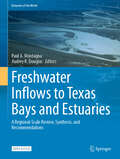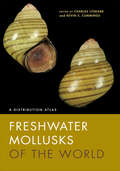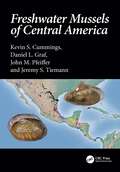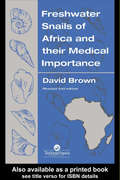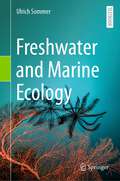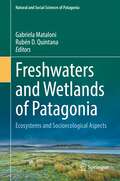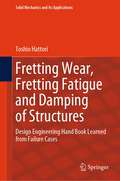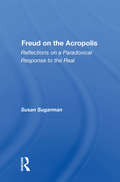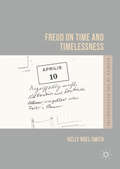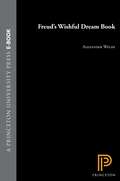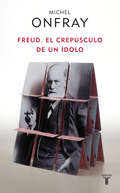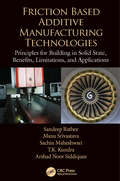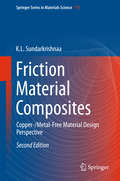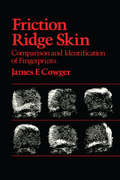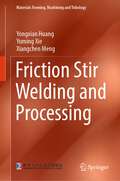- Table View
- List View
Freshwater Fishes of North America: Volume 2: Characidae to Poeciliidae
by Joseph R. TomelleriThe highly anticipated second volume of Freshwater Fishes of North America, a monumental, fully illustrated reference that provides comprehensive details on the freshwater fishes of the United States, Canada, and Mexico.When the first volume of Freshwater Fishes of North America was published, it was immediately hailed as the definitive reference in the field. Readers have been fervently awaiting the next volume in this encompassing three-book set ever since. Now complete, volume 2, covering families Characidae to Poeciliidae, is the result of decades of analysis by leading fish experts from universities and research laboratories across North America.Each volume in this authoritative synthesis covers the ecology, morphology, reproduction, distribution, behavior, taxonomy, conservation, and the fossil record of the included North American fish families. The encyclopedic reviews of each family are accompanied by color photographs (nearly 250 in this volume alone), range maps, and artwork created by noted fish illustrator Joseph R. Tomelleri. The result is a rich textual and visual experience that covers everything known about the diversity, natural history, ecology, and biology of North American freshwater fishes.Volume 2 covers the following North American families of fishes:Characidae (Characins)Ictaluridae (North American Catfishes)Ariidae (Sea Catfishes)Heptapteridae (Three-barbeled Catfishes)Osmeridae (Smelts)Esociformes (Esocidae, Pikes and Umbridae, Mudminnows)Percopsidae (Trout-perches)Amblyopsidae (Cavefishes)Aphredoderidae (Pirate Perches)Gadidae (Cods and Cuskfishes)Mugilidae (Mullets)Atherinopsidae (New World Silversides)Beloniformes (Needlefishes and Halfbeaks)Rivulidae (New World Rivulines)Profundulidae (Middle American Killifishes)Goodeidae (Goodeids)Fundulidae (Topminnows)Cyprinodontidae (Pupfishes)Poeciliidae (Livebearers)The chapter authors of Volume 2 are:Gianetta AdamsClyde BarbourMicah BennettRicardo Bentancur-R.Peter B. Z. BerendzenBrooks M. BurrMollie CashnerRobert C. CashnerBruce B. ColletteMatthew DavisAlice F. EchelleAnthony A. EchelleFernando GalvezMichael GhedottiNicholas GidmarkTerry GrandeRobert L. HopkinsLauren M. KuehneFrank McCormickNorman Mercado-SilvaAnn U. O'ConnellMartin T. O'ConnellJulian D. OldenClaudia Patricia Ornelas-GarciaMark Sabaj PerezKyle R. PillerSteven PowersJacob SchaeferJuan J. Schmitter-SotoAndrew M. SimonsRoger A. TaborCheryl ThieleMatthew ThomasMelvin L. Warren, Jr.Mark V. H. Wilson
Freshwater Inflows to Texas Bays and Estuaries: A Regional-Scale Review, Synthesis, and Recommendations (Estuaries of the World)
by Paul A. Montagna Audrey R. DouglasEstuaries are defined by mixing of river and sea water, thus freshwater inflow is a key driver of estuary ecosystem structure and function. While there is much concern about water quality, there is much less about water quantity. As water is diverted for human use, less is flowing to the coast, which threatens estuary ecosystems. Some jurisdictions are now setting inflow standards, but there is no consensus on how to identify how much freshwater an estuary needs. There is a climatic gradient along the northwestern Gulf of Mexico coast and estuaries vary from hydrologically positive to neutral to negative, and this makes the Texas coast the ideal place to study how ecological processes vary with freshwater inflow. An estuary comparison approach is used in this open access work to examine hydrology, circulation, salinity, nutrients, carbonate, dissolved oxygen, plankton, nekton, benthos, and habitat dynamics and responses across varying hydrological regimes.
Freshwater Mollusks of the World: A Distribution Atlas
by Charles Lydeard and Kevin S. CummingsThe definitive resource on the biology and evolution of freshwater mollusks.There are more species of freshwater mollusks—well over 5,000—than all the mammal species of the world. Freshwater mollusks are also arguably the most endangered fauna on the planet. Yet few references exist for researchers, shell enthusiasts, and general readers who are interested in learning more about these fascinating creatures. In Freshwater Mollusks of the World, Charles Lydeard and Kevin S. Cummings fill that void with contributions from dozens of renowned mollusk experts.Touching on 34 families of freshwater gastropods (snails) and 9 families of freshwater bivalves (mussels and clams), each chapter provides a synthesis of the latest research on the diversity and evolutionary relationships of the family. The book also includes• a look at how evolving DNA sequencing data techniques help shed light on mollusk taxonomy• distribution maps of each family's biogeographic locales• a representative photo and distribution map for each of the freshwater mollusk families • the latest information on each family's conservation status—and how to reverse the habitat destruction, modification, and pollution that threatens it• a discussion of the ecological and economic damages caused by invasive mollusk species, as well as their role as disease vectorsMollusks provide us with amazing biogeographical insights: their ancient fossil record goes back over 500 million years, and their distribution patterns are a reflection of past continental and climate changes. The only comprehensive summary of systematic and biodiversity information on freshwater mollusk families throughout the world, this reference is a must for malacologists, limnologists, ichthyologists, stream ecologists, biogeographers, and conservation biologists.Contributors: Christian Albrecht, Rüdiger Bieler, Bert Van Bocxlaer, David C. Campbell, Stephanie A. Clark, Catharina Clewing, Robert H. Cowie, Kevin S. Cummings, Diana Delicado, Hiroshi Fukuda, Hiroaki Fukumori, Matthias Glaubrecht, Daniel L. Graf, Diego E. Gutiérrez Gregoric, Kenneth A. Hayes, Yasunori Kano, Taehwan Lee, Charles Lydeard, Nathaniel T. Marshall, Paula M. Mikkelsen, Marco T. Neiber, Timea P. Neusser, Winston Ponder, Michael Schrödl, Alena A. Shirokaya, Björn Stelbrink, Carol A. Stepien, Ellen E. Strong, Maxim V. Vinarski, Amy R. Wethington, Thomas Wilke
Freshwater Mussel Propagation for Restoration
by Matthew A. Patterson Rachel Mair Nathan Eckert Catherine M. Gatenby Tony Brady Jess W. Jones Bryan R. Simmons Julie L. DeversFreshwater mussels are declining rapidly worldwide. Propagation has the potential to restore numbers of these remarkable organisms, preventing extinction of rare species and maintaining the many benefits that they bring to aquatic ecosystems. Written by practitioners with firsthand experience of propagation programs, this practical book is a thorough guide to the subject, taking readers through the process from start to finish. The latest propagation and culture techniques are explored as readers follow freshwater mussels through their amazing and complex life cycle. Topics covered include the basics of building a culture facility, collecting and maintaining brood stock, collecting host species, infesting host species with larval mussels, collecting and culturing juvenile mussels, releasing juveniles to the wild, and post-release monitoring. This will be valuable reading for any biologist interested in the conservation of freshwater mussel populations. A step-by-step description of the mussel propagation process shows readers tried and tested techniques, helping them avoid pitfalls that other practitioners have faced; Includes a description of the basic biology of freshwater mussels, helping readers understand how their life cycle will affect propagation efforts; A thorough analysis of the key questions to ask before starting a propagation program will help readers start the process with clear objectives in mind.
Freshwater Mussels of Central America
by Kevin S. Cummings Daniel L. Graf John M. Pfeiffer Jeremy S. TiemannThis book describes a fauna of global conservation concern and provides a framework for researchers to begin to test hypotheses regarding the evolution of freshwater mussels in Central America. Placing the Central American fauna in context with that of North and South America, the authors fill a gap in our knowledge of this endangered and largely endemic fauna. This book: Provides a full‑color treatment of all 81 native and introduced freshwater mussel species found from the Río Grande in Texas, USA, and México to Colombia, South America Includes 110 distribution maps of all species Presents complete synonymies in every systematic species account Offers historical information and bios of previous workers in the field Cites complete literature and references on freshwater mussels in the region Through photographs, distribution maps, and a complete list of species described and reported from Central America, Freshwater Mussels of Central America will inspire researchers to begin filling in the gaps regarding the systematics and ecology of freshwater mussels in Central America. It will be an essential source for conservationists, aquatic biologists, and those interested in the natural history of temperate and tropical freshwater ecosystems.
Freshwater Recreational Fishing: The National Benefits of Water Pollution Control (Routledge Revivals)
by Clifford S. Russell William J. VaughanThe Federal Water Pollution Control Act, signed into law in 1972, dramatically redirected the nation’s water pollution control efforts and set out ambitious national goals, expressed both in terms of discharge controls and of resulting water quality. Originally published in 1982, this title examines the benefits that a reduction in the discharge of water pollutants has for recreational fisherman including an increase in the total availability of fishable natural water bodies and an improvement in the aesthetic quality of the fishing experience. It is a valuable resource for students interested in environmental studies and public policy making.
Freshwater Red Algae: Phylogeny, Taxonomy and Biogeography
by Morgan L Vis Orlando Necchi JrThis book presents the phylogeny, taxonomy and biogeography of freshwater red algae. Its content is divided into five chapters. The first chapter provides a brief history of freshwater red algal research, habits and collecting methods, general biogeographic trends and an overview of the taxonomic/phylogenetic placement of freshwater taxa. The other four chapters are taxonomic treatments of non-marine red algae based on taxonomic levels, i.e. classes within the phylum Rhodophyta, orders within each class, families within each order, and genera within each family. Descriptions, phylogenetic data (including numerous trees), geographic range (maps for most species) and dichotomous keys for identification are presented. Comprehensive data are provided for more than 220 species.
Freshwater Snails Of Africa And Their Medical Importance
by David S BrownThe first half of this book is primarily a systematic survey of the snails, beginning with glossaries, keys for identification to genera and a checklist of species. This is followed by a synopsis of species, with brief notes on ecology, distribution and parasites. Relationships are then described between snails and schistosomes and with other paras
Freshwater and Marine Ecology
by Ulrich SommerFreshwater and Marine Ecology is an introduction to the field of aquatic ecology, integrating the conceptually and methodologically widely overlapping fields of limnology and biological oceanography. It is structured like most textbooks of general ecology, leading from more elemental entities (individuals having to cope with their environment) to increasingly overarching entities, from populations over communities and ecosystems to the biogeochemistry of the entire planet and, finally, an overview over the major human impacts on the aquatic components of the earth system. The book provides examples for all major theoretical concepts of general ecology while the usual ecology textbooks have a strong terrestrial bias and rely only on few aquatic examples. This book takes the contrasting approach, motivated by the fact the fact that life originated from aquatic systems and that surface waters cover more than 70% of the Earth’s surface. The choice of studies used as examplesin Freshwater and Marine Ecology provides a balanced mix of freshwater and marine studies, of field observations, experimental and modeling studies. The readers are confronted with very recent work leading to the forefront of contemporaneous research but also with classic studies which laid the foundations of theory development in the field. Freshwater and Marine Ecology is a comprehensive text ideally serving for undergraduate courses in biological oceanography, limnology, and ecology, but also for advanced students, teachers and scientists who had limited exposure to aquatic sciences and/or ecology during their studies.
Freshwater habitats : life in freshwater ecosystems
by Laurie ToupinA look at the plants, animals, locations, and various habitats that make up the freshwater ecosystems of the world.
Freshwaters and Wetlands of Patagonia: Ecosystems and Socioecological Aspects (Natural and Social Sciences of Patagonia)
by Gabriela Mataloni Rubén D. QuintanaThe Freshwaters of Patagonia adopts a socioecological approach, in which experts from across Patagonia review recent, scientifically rigorous literature and data of their own, thus synthesizing the current knowledge directly relevant to understand the present state and future trends of icefields, freshwater and wetland ecosystems in this region.The book’s organization into three parts provides a studied and comprehensive view on the patterns and processes of the various ecosystems in Patagonia, and describes the sociological aspects of freshwater ecosystems, as well as characterizes the conservation of the freshwater and wetland ecosystems, in Patagonia. The chapters offer a broad, state-of-the-art overview of the current status of glaciers, freshwater and wetland ecosystems of this region, as well as studies of both local and large scale biodiversity patterns, and study cases of extreme and naturally polluted environments.The volume concludes with the current status of Patagonian freshwaters, and discusses the scientific, legal and administrative tools aimed at their sustainable management within the framework of the UNEP Sustainable Development Goals 2030 Agenda. A broad audience of students, scientists, engineers, environmental managers, and policy makers will be interested in this volume.
Fretting Wear, Fretting Fatigue and Damping of Structures: Design Engineering Hand Book Learned from Failure Cases (Solid Mechanics and Its Applications #276)
by Toshio HattoriThis book provides a comprehensive overview of the mechanical distinctions between fretting damage under axial or bending external forces and fretting damage under a torsional load. It emphasizes the importance of studying practical accident cases to efficiently acquire technical skills. The book is structured around the fundamental technologies of material science, tribology, and mechanics, which are vital for understanding and addressing technical issues. The author has incorporated all fretting countermeasure technologies, which were previously often sensory and empirical in nature, and repositioned them as technologies grounded in fundamental principles. The book proposes an economical approach to product operation that maintains reliability by integrating not only design technology but also maintenance practices. It delves into specific materials, such as titanium alloys and aluminum alloys, which have seen increased use for weight reduction in industries like aerospace. In this book, “Critical Distance Stress Theory” that can easily derive the fatigue limit and fatigue life of the stress singular field at the contact edge was presented. As a result, the fretting fatigue strength and life can be predicted from the same FEM stress analysis as the normal stress concentration part. And finally, introducing a novel fretting mechanical model, the book focuses on scenarios where pressure force (N) and repeated tangential force (F) are applied to two planar objects, with the tangential force being transmitted solely through friction at the contact surface. This model finds relevance in turbine blade connection structures, among other applications. The author references Asai's research example, which encompasses fretting mechanical analysis, fretting wear evaluation, fatigue assessment, and structural damping evaluation using this model.
Freud On The Acropolis: Reflections On A Paradoxical Response To The Real
by Susan SugarmanIn this book, the author tracks the canonical instances of the generalized version of Sigmund Freud's example: a visit to the Acropolis when one cares about the visit, whether or not with the degree of interest and enthusiasm that Freud had.
Freud and the Émigré: Austrian Émigrés, Exiles and the Legacy of Psychoanalysis in Britain, 1930s–1970s
by Elana Shapira Daniela FinziThis book reconsiders standard narratives regarding Austrian émigrés and exiles to Britain by addressing the seminal role of Sigmund Freud and his writings, and the critical part played by his contemporaries, in the construction of a method promoting humanized relations between individual and society and subjectivity and culture. This anthology presents groundbreaking examples of the manners in which well-known personalities including psychoanalysts Anna Freud and Ernst Kris, sociologist Marie Jahoda, authors Stefan Zweig and Hilde Spiel, film director Berthold Viertel, architect Ernst Freud, and artist Oskar Kokoschka, achieved a greater impact, and contributed to the broadening of British and global cultures, through constructing a psychologically effective language and activating their émigré networks. They advanced a visionary Viennese tradition through political and social engagements and through promoting humanistic perspectives in their scientific, educational and artistic works.
Freud on Interpretation
by Robert W RieberThis book presents new insights into Freud's famous "discovery" of the unconscious and the subsequent development of psychoanalytic theories. The authors explore the original context in which these ideas arose and the central debate about mind as matter or something that transcends matter. In the course of this examination, it is demonstrated that Freud was influenced not only by the 19th century scientific milieu, but also by ancient cultures. While it is known that Freud was an avid collector of ancient artifacts and generally interested in these older cultures, this book systematically investigates their profound effect on his thinking and theorizing. Two major influences, Egyptian mythology and Jewish mysticism are analyzed in terms of similarities to Freud's emerging ideas about the mind and its diseases. To further this line of investigation, Bakan supplies an illuminating discussion of what it means to interpret. Taken from the viewpoint that interpretation involves an u
Freud on Time and Timelessness
by Kelly Noel-SmithTime and timelessness are fundamental principles of psychoanalysis yet Freud does not present a consolidated theory of temporality. In this book Kelly Noel-Smith pieces together Freud's scattered 'hints' and 'suspicions' about time and its negative, timelessness. She traces a careful temporal trail through Freud's published works and his daunting Nachlass, and provides a compelling reason as to why Freud kept his remarkable thoughts about time to himself.
Freud's Wishful Dream Book
by Alexander WelshAlthough it is customary to credit Freud's self-analysis, it may be more accurate, Alexander Welsh argues, to say that psychoanalysis began when The Interpretation of Dreams was published in the last weeks of the nineteenth century. Only by going public with his theory--that dreams manifest hidden wishes--did Freud establish a position to defend and embark upon a career. That position and career have been among the most influential in this century. In August 1899, Freud wrote to Wilhelm Fliess of the dream book in terms reminiscent of Dante's Inferno. Beginning from a dark wood, this modern journey features "a concealed pass though which I lead the reader--my specimen dream with its peculiarities, details, indiscretions, bad jokes--and then suddenly the high ground and the view and the question, Which way do you wish to go now?" Physician that he is, Freud appoints himself guide rather than hero, yet the way "you" wish to go is very much his prescribed way. In Welsh's book, readers are invited on Freud's journey, to pause at each concealed pass in his seminal work and ask where the guide is taking them and why. Along the way, Welsh shows how Freud's arbitrary turnings are themselves wishful, intended to persuade by pleasing the reader and author alike; that his interest in secrets and his self-proclaimed modest ambition are products of their time; and that the book may best be read as a romance or serial comedy. "Some of the humor throughout," Welsh notes, "can only be understood as a particular kind of fine performance." Welsh offers the first critical overview of the argument in Freud's masterpiece and of the author who presents himself as guide.
Freud: El crepúsculo de un ídolo
by Michel OnfrayEl prestigioso filósofo francés Michel Onfray, autor del best seller Tratado de ateología, ha escrito un ataque virulento contra el psicoanálisis, y en particular contra el freudismo, vehementemente argumentado y que ha creado una gran polémica en Francia. Onfray parte en este libro de una idea simple pero radical: Freud quiso construir una «ciencia» y no lo consiguió; quiso «probar» que el inconsciente tenía sus leyes, su lógica intrínseca, sus protocolos de experimentación, y usó todos los medios a su alcance para adornar el psicoanálisis con la apariencia de lo científico. Con gran rigor, Michel Onfray reexamina las obras de Freud, así como su biografía, para desvelar sus inconsistencias y contradicciones y ofrecer una conclusión implacable: el psicoanálisis no es más que el producto de influencias de la psicología, de la literatura y de la filosofía, pero en ningún caso es la ciencia a la que aspiraba su fundador. La crítica ha dicho...«Un ensayo potente, inteligente e inquietante, escrito de manera simple y directa, hábilmente argumentado y organizado en torno a una tesis sistemáticamente desarrollada.»Robert Maggiori, Libération «Un libro tan contundente como Tratado de ateología.»Livres Hebdo «No solo importante sino también apasionante. Este libro ya es un clásico. Como dice Onfray, ya era hora de sacar a Freud de la leyenda para introducirlo en la historia, donde será discutido, atacado y, por supuesto, defendido.»Le Point «Dejando atrás el freudismo de postal, Onfray se entrega a la deconstrucción de un sistema.»L'Express «Un gran incendio mediático.»Paris Match
Friction
by Matt MullinsA True Book--Physical Science Whether you're an aspiring inventor or an everyday science buff, you've probably created your own experiments to uncover the truth about the forces of physical science. Now you can delve deeper into the topics of electricity, motion, gravity, and more with these titles that are perfect for the budding scientist in you.
Friction Based Additive Manufacturing Technologies: Principles for Building in Solid State, Benefits, Limitations, and Applications
by Sandeep Rathee Manu Srivastava Sachin Maheshwari T. K. Kundra Arshad SiddiqueeCurrently, most of the major commercial metal additive manufacturing (MAM) techniques rely on liquid phase processing. The liquid to solid phase transformations in these techniques results in microstructural issues and defects which in turn tantamount to inferior properties of fabricated build. Friction based additive manufacturing technologies are solid state processing techniques which work on the principles of friction based joining processes and layer by layer additive manufacturing. This book primarily addresses the basic understanding of seven friction based additive manufacturing techniques. These techniques include additive manufacturing methods based on rotary friction welding, linear friction welding, friction deposition, friction surfacing, friction stir additive manufacturing, friction assisted seam welding and additive friction stir. The principle of operations, benefits, limitations and recent developments of each technique has been described. It covers potentional and probable applications of each technique through review of various experimental studies. Features Targets friction based solid state additive manufacturing of metallic materials Describes principle of operation of seven friction based additive manufacturing techniques Reviews latest trends of these processes via experimental studies Describes benefits and limitations of each technique Covers current and probable applications of these techniques
Friction Material Composites
by K. L. SundarkrishnaaFriction Material Composites is the first volume of the five volumes which strongly educates and updates engineers and other professionals in braking industries, research and test labs. It explains besides the formulation of design processes and its complete manufacturing input. This book gives an idea of mechanisms of friction and how to control them by designing .The book is useful for designers of automotive, rail and aero industries for designing the brake systems effectively with the integration of friction material composite design which is critical. It clearly emphasizes the driving safety and how serious designers should select the design input. The significance of friction material component like brake pad or a liner as an integral part of the brake system of vehicles is explained. AFM pictures at nanolevel illustrate broadly the explanations given.
Friction Ridge Analysis: Applications of Nanoparticles for Latent Fingerprint Development (Materials Horizons: From Nature to Nanomaterials)
by Kumud Kant Awasthi Mahipal Singh Sankhla Sally Lukose Kapil PariharThe book presents emerging techniques for the development of latent fingerprint on various surfaces using nanotechnology. It explores the use of nanoparticles for the development of fingerprints. Various topics covered in this book include chemistry of nanomaterials for finger printing, quantum dots in fingerprinting, florescent nanoparticles in fingerprinting, nanocomposite and hybrid materials for fingerprints, carbon-based nanomaterial, silver and gold nanoparticles development of fingerprint, zinc oxide nanoparticles, silica nanoparticles for development of fingerprints, etc. Given the contents, the book will be highly useful for the students, researchers and professionals working in the areas of forensic science and nanotechnology.
Friction Ridge Skin: Comparison and Identification of Fingerprints (Practical Aspects Of Criminal And Forensic Investigation Ser. #Vol. 2)
by James F. CowgerHere is a complete guide to the collection, classification, and comparison of friction skin prints and the determination of identity and nonidentity. It discusses: the cause and significance of variations in prints; the importance of class characteristics in print; the application of probability in decision making; and photographic techniques and considerations.
Friction Science and Technology: From Concepts to Applications, Second Edition
by Peter J. Blau"Should have broad appeal in many kinds of industry, ranging from automotive to computers-basically any organization concerned with products having moving parts!"-David A. Rigney, Materials Science and Engineering Department, Ohio State University, Columbus, USAIn-Depth Coverage of Frictional ConceptsFriction affects so many aspects of daily l
Friction Stir Welding and Processing (Materials Forming, Machining and Tribology)
by Yongxian Huang Yuming Xie Xiangchen MengThis book introduces the principles and characteristics of friction stir welding and processing. Based on the inherent issues of friction stir welding, such as back support, weld thinning, and keyhole defects, the book summarizes innovative technologies related to solution strategies and presents a wide range of examples. It introduces the advantages and joining mechanism of friction stir welding in the joining of dissimilar materials and explains the importance of combining metallurgical bonding and mechanical joining. It also includes the characteristics of friction stir processing in terms of microstructure refinement, mechanical properties, surface modification, and the preparation of composites. This book is of interest to a broad readership in various fields of materials science and engineering.

